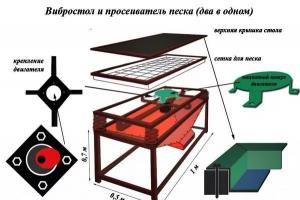The practice of berry pickers in the wild shows that a special manual harvester is the most convenient means for collecting lingonberries in the wild. Despite certain disadvantages and even a ban on its use in some countries (including Russia), it is with this type of combine that the bulk of lingonberries are harvested in forests and on many plantations.
Classic harvester for collecting lingonberries
Indeed, such a device greatly simplifies the task of picking berries. The video shows how such a device collects in the forest:
With developed skills in use, the combine speeds up the collection of berries by 2-3 times compared to manual collection, and therefore is widely used by harvesters. And in countries where such devices are approved for use (mainly in Scandinavian countries - Sweden, Norway, Finland), they are produced by industry and are widely used by the population. Moreover, such devices must strictly comply with safety requirements so that their use does not lead to injury to bushes and a decrease in yield even in the wild.
Actually, it is for this reason that such combines are prohibited for use in Russia and Belarus: methods of monitoring what the population uses have not been worked out, and most assemblers prefer to use imported machines instead of safe and harmless ones. homemade devices, which lead to injury to the bushes and loss of green mass. In such conditions, it is easier to ban combines.
On a note
People call tools for picking berries differently - “scrapers”, “combs”, “grabbers”, “peelers” and others. Some of these names specifically indicate the roughness of the tool and its traumatic nature for bushes.
However, it is obvious that progress is behind such devices, and sooner or later the ban on their use will be lifted, but only those that do not harm the bushes can be used. Therefore, let's figure out what a harvester looks like, which makes the task of picking berries easier and does not harm berry bushes, what varieties it has, how it works, how much it costs and how to make such a safe tool with your own hands.
What is such a combine?
Structurally, the harvesting combine is a deep bucket, to which a special comb with long teeth is attached at the front bottom, and a handle for holding the entire device is located at the top.

The disadvantage of this model is the thin metal handle, which is uncomfortable to hold and quickly rubs calluses.
The main working body of such a device is the comb. The length of its teeth is 10-20 cm, so that in one movement you can grab and “comb” an entire lingonberry bush. The distance between the teeth is approximately 4-5 mm. It is into such gaps that the leaves and stems of the bush easily fit, but the berries no longer fit.
Practice shows that a lingonberry harvester is also suitable for harvesting cranberries, bearberries, as well as large blueberries and blueberries. Small blueberries fit between the teeth and are easily crushed. Other berries - strawberries, cloudberries, currants - cannot be harvested with such combs, since the leaves of their bushes are very large and do not fit between the teeth.
The receiving compartment of the device is blind; berries picked with a comb accumulate in it.
When working, the picker holds the scoop in his hand, brings the comb to the base of the bush and simply lifts it up. Stems, branches and leaves pass between the teeth, and the berries are torn off and rolled into the depths of the receiving chamber. At one time or another, the picker pours the berries from the harvester into a bucket or basket.
This way you can pick berries from one bush in a few seconds. When collecting manually, the same operation takes at least a minute.
In well-designed harvesters, the comb does not have sharp cutting edges and therefore does not scratch the plant stems or tear off leaves. Even the edges of the teeth are rounded and do not scratch the stems. That is, in a good case, the tool is harmless to lingonberry bushes. In many cases, when such devices are made by hand, they contain areas that are dangerous for plants, which cause damage to the bushes.
Such devices are manufactured by many manufacturers and therefore have different appearance and design features.
For example, Finnish MARJUKKA combines are very famous in Karelia and the Leningrad region. They are made of durable plastic and therefore are quite lightweight, but at the same time durable. The photo shows classic version such a device:

You can buy such a harvester in an online store for about 750 rubles - it will pay for itself in just a few days of harvesting.
And here is a model for children in the shape of a fox: 
Its price is similar - 750 rubles.
Simpler devices can be made of steel:

and sometimes they don’t even have teeth, but simply a rounded lattice in the front part:

You can order them at a price of 600-650 rubles per unit.
These are the models that are considered the safest. Already these options:

...rip off a large number of leaves that do not fit between the teeth. It is these harvesters and their analogues that are considered poachers and it is with them that the Ministry of Natural Resources is fighting. And they are the ones that cost less (in the range of 300-400 rubles), which is why they are most popular among the population.
And on cranberry or blueberry plantations, real mobile harvesters are used:
Actually, these manual deep buckets with handles are also called manual harvesters. However, other devices for picking berries, often not at all similar to buckets, work on a similar principle.
Similar designs: rakes, scoops, shovels, combs and others
The principle of “picking” berries from herbaceous bushes is implemented in some devices, either simpler in design, or designed to further simplify the work of the picker.
For example, the most simple options- these are ordinary wooden scoops with long teeth on the leading edge:

Some of their options are simplified as much as possible:

And in some homemade models an excellent balance is maintained between simplicity, cheapness and functionality. For example, here's a combine:

It is made of wire, thread and a bag, but is very compact and is not inferior in ease of use to industrial options.
In these cases, the typical combine design is simplified for the fastest possible production. However, these options have their drawbacks. For example, the scoop has low sides and if accidentally tilted, the berries easily spill out of it. A wooden ladles quickly become dirty.
In other cases, inventors are working to make it possible to use a harvester to pick berries without bending over or crawling through the forest on your knees. The simplest option in this case is a special rake:
They can be used to comb the bushes without bending over, from time to time pouring the collected berries into a bucket.
More difficult option- This is a combination of a rake and a combine. Simply put, the combine has a long handle that allows you to change the angle of the bucket itself. The video shows an example of such a device:
And, by the way, please note: even such complex designs It’s entirely possible to do it yourself. And when correct production the resulting combine will be no worse than an industrial one. Therefore, it is worth saying a few words about how to correctly implement the basic principle in such a product.
How to make such a device with your own hands?
The easiest way to make a scoop for picking berries is to take a regular scoop and cut teeth into it so that the gap between the teeth is at least 5 mm. The photo shows an example of what should happen in the end:

The disadvantage of this design is the handle located at the back. Practice shows that it is much more convenient if the handle is on top. In this case, the risk of berries spilling out of the receiving chamber of the scoop is less high, and the hand holding the scoop is in a natural position. Accordingly, the wrist does not strain and the device can be used to pick berries for a long time.
The video shows how to make a real harvester with your own hands:
Below are drawings according to which the body of the combine itself can be cut out of metal, onto which a grid with a ridge will later be attached:

The width of the combine can be greater if necessary.
Finally, you can make a rake for berries if you have a tool for working with metal:

In some cases, craftsmen manage to make fully functional devices literally from tin cans and scraps of lumber:

As you can see, the build quality here is not bad, but the appearance of the products still leaves much to be desired. Be that as it may, how quickly and easily it will be possible to collect lingonberries with such a device will depend only on how skillfully the picker works with the ladle itself. Often, a person with the most primitive device collects more berries than his colleague with an expensive imported scraper, simply because he does not make unnecessary movements and makes all movements more efficiently.
However, it is important to remember that the speed of harvesting lingonberries most often directly correlates with harm to the plants themselves (especially with poor harvesting techniques).
Is mechanized berry picking harmful to berry bushes?
Even the highest quality harvester in any case injures the bushes more than a person picking lingonberries by hand does. At a minimum, some of the leaves and individual shoots are still torn off and end up in the receiving chamber. And on very light forest soil, especially with a moss bedding, individual bushes can be torn out entirely if the stem accidentally becomes intertwined in the ridge. One-time cases of such damage are, in principle, not critical. But we must take into account that thousands of people pick berries in the forest in the summer; most of them use rough, rather than gentle, imported scoops. homemade structures, which can break or pull out bushes literally “in one go.”
Observations in nature and forestry logs show that areas in the forest that are under heavy pressure from berry pickers very quickly lose their productivity. How more people In this or that area, berries are collected using combines, the worse this area will bear fruit in a year. And with constant harvesting, the yield decreases every year.

Perhaps, in just a few years, it will hardly be possible to collect at least one bucket from the same plot from which these berries were now collected.
At the same time, according to environmental organizations in Finland and Sweden, with proper control by foresters and disciplined pickers, the use of combines does not affect the yield of berry fields in the forest. In these countries, the designs of devices that can be used for picking berries are strictly regulated, and serious fines are imposed for violations of the requirements. As a result, the population mainly uses safe designs, thanks to which the berry growers themselves do not suffer.
In Russia and Belarus, pickers also note that with proper, careful harvesting, using only gentle modern combines and a small number of pickers (when the bushes are not trampled), the harm from the harvesters themselves is practically not felt, and the berry plants bear fruit the same whether with manual picking or with delicate picking special combs. Where there are a lot of people, and the pickers do not disdain any devices, working on the principle “after us, even a flood,” berry growers die out.
Administrative responsibility for the use of combines
Today in Belarus, Ukraine and Russia, wild berries are collected using mechanical hand-held devices(harvesters) is prohibited by law. The fine for violation in Ukraine is about 1900 UAH, in Bulorussia - 420 rubles, in the Russian Federation - 4000 rubles. At the same time, having a combine harvester with you in the forest is not considered a crime. The forester can fine only if he catches the picker red-handed - both with the harvester and with the berries.
 Berry harvesters not only help to significantly facilitate the process of picking blueberries, lingonberries, cranberries and other berries, but also make this process as efficient as possible, reducing losses and shortening the time of activities.
Berry harvesters not only help to significantly facilitate the process of picking blueberries, lingonberries, cranberries and other berries, but also make this process as efficient as possible, reducing losses and shortening the time of activities.
Users can choose either a production model or design a manual harvester for picking berries with their own hands. The configurations of such devices are quite simple, and following the instructions and drawings, creating them is quite easy.
Features of blueberry harvesters
Picking blueberries is a very labor-intensive process, and care must be taken, since the berries, although dense, are easy to damage. Plastic containers or baskets are used, and you should not frequently move the crop from one container to another.
Factory-produced berry harvesters
 The most common design has become a manual blueberry harvester in the form of a scoop. Despite the fact that it is extremely simple, the device speeds up the process three or four times. The cost of a blueberry harvester is not high, but you can find it in the hardware department or in garden tools. The equipment is known to users under several names:
The most common design has become a manual blueberry harvester in the form of a scoop. Despite the fact that it is extremely simple, the device speeds up the process three or four times. The cost of a blueberry harvester is not high, but you can find it in the hardware department or in garden tools. The equipment is known to users under several names:
- Berry
- Fruit picker.
- Berry harvester.
Design
- The container of the device has the shape of a parallelepiped.
- On the underside there are elongated curved teeth for combing out berries.
- The gap between the teeth is five, six millimeters.
Branches with foliage easily pass between the cloves without being damaged, and the berries are torn off and sent to the back of the equipment. Among the various models, the berry harvester made in Finland is very popular. The body of homemade and factory-made products can be metal, plastic or wood. As for the teeth, they are almost always made of wire.
How to make a blueberry harvester with your own hands?
 It’s quite easy to make a blueberry harvester with your own hands; for this you will need:
It’s quite easy to make a blueberry harvester with your own hands; for this you will need:
- Patterns of paper parts - two side walls and one back, bottom, handle, part with teeth.
- Place the pattern on the surface of the material from which the body will be made, trace and cut.
- Fasten all the components according to the diagram.
Using the drawings, creating a blueberry harvester with your own hands is quite simple. For the teeth you can use wire. After making several long loops, secure them to the bottom of the device.
Cranberry harvester
One of the most popular combines for harvesting cranberries is the Toropushka device. Manual fixture damages plants, ensuring gentle and quick harvesting. The device is equipped with a capacious storage sleeve into which the picked berries are sent. To pour them into the tank, just one movement of your hand is enough. If you want to make a popular Toropushka cranberry harvester with your own hands, look at the drawings.
Design Features:

- The cranberry harvester has solid metal baffles to prevent bunches of plants from getting tangled. This allows grass and moss to escape without problems, leaving the berries in the container.
- The springiness of the plates does not tear leaves from the branches.
- Thanks to the rounded shape of the device, berries can be removed even from recesses.
- The sleeve is made of fabric, which reduces the time it takes to extract berries - you will need to lower the edge of the sleeve into the container.
Harvester for collecting lingonberries
A convenient and efficient manual harvester for collecting lingonberries was previously produced by domestic manufacturers. Its configuration is similar to other devices for berries:

- Body equipped with a handle.
- Bottom with a comb made of wire.
- A metal partition located inside the manual berry harvester, covering the cross-section of the body, prevents accidental loss of lingonberries.
- The partition is fixed in the side plates of the housing so that it can be easily rotated to access the berries directly into the combine.
This design is often used to make do-it-yourself berry harvesters. Today, inexpensive models made of durable plastic are increasingly used. Most often on the market you can find Finnish berry harvesters, which have proven themselves to be excellent for working with various harvest volumes.
All experienced gardeners preparing for the arrival of summer from spring. Some people buy gardening equipment in stores, while others make their own. The berry harvester is an indispensable assistant for each owner garden plot. With its help you can quickly collect fruits in large quantities. Let's take a closer look at the design features and how to make a berry harvester with your own hands.
Scheme and materials
Before you make a berry harvester, you need to prepare a certain set of tools and materials. In general, such a device is similar to a regular scoop, but it has a different purpose.

To work you will need:
- sheet steel material;
- fasteners;
- tree branches;
- metal wire;
- drill.
The device acts as a body with an additional handle and a bottom, as shown in the drawing. The design has a comb, which eliminates the possibility of fruit falling out during the assembly process. There is also a special partition, thanks to which you can harvest in large quantities. A handle is fixed to the upper area, providing comfortable conditions for work.
The main part consists of plywood or plastic material, all other components are made of wire.
Option one - manufacturing stages
Before you make a blueberry harvester, you need to correctly calculate all the dimensions and create a construction diagram. IN as a last resort, you can use ready-made solution, which is provided on our website.
- From purchased plywood, durable plastic or metal sheet cut out the main body and bottom of the berry harvester.

Plywood base
- Next you need to make the remaining components of the comb. For this, 3 mm wire is used. Make the required number of 10 cm pins.
- On one side it is necessary to fix the galvanized steel.

Proportions and dimensions of the device
- Create several holes, their diameter should be equal to the cross-sectional size of the rods. The holes must be located on the side of the platinum. Set the teeth in 4mm increments.
- Make a small bead by bending the end of the plate. Secure the rods in the holes with wood slats. Solder the wire to the base of the blueberry processor.
- Bend the edge at a right angle into the inside of the device. The bottom will be fixed to this part. It is necessary to create stiffening ribs along the side. Place the handle here.
A manual blueberry harvester will serve as an indispensable assistant in this process. The steel device is practical, resistant to mechanical stress and durable.
Option two
This method involves making a do-it-yourself blueberry harvester from wood. To work you will need:
- skewers for cooking kebabs;
- large tree branches with a diameter of 100-120 mm;
- saw;
- adhesive composition;
- chisel;
- drill.
Taking into account the diagram and given dimensions, cut two identical circles with a small thickness from the wood blocks.

Step back 1 cm from the edges and at this distance make holes along the entire circumference on two parts.


The cross-section size must fully correspond to the diameter of the skewers. All holes should be located at a distance of up to 5 mm from the previous ones.

Using a drill, we make through holes where the skewers should fit. The distance between the holes depends on the size of the berries - the larger the berry, the greater the distance

The result will be a convenient hand-made berry harvester made by yourself.
.jpg)
The easiest way
The simplest collection is a construction made of dense plastic bottle. Use opaque plastic containers for ketchup, kefir or milk. Such a tank fully complies with the required strength indicator and is easy to work with. The bottle must have small sizes, as well as a wide neck for quick and easy fruit removal.

How to make a collection from plastic containers:
- mark the location of the hole on the bottle;
- fix the stick on the device so that it ends near the bottom of the container and protrudes on the other side;
- A square-shaped hole is cut along the mark, but large teeth are made on one side, near the bottom.
A homemade fruit picker made from improvised materials is ready for use.
VIDEO: How to make convenient device himself
Rating of the best models of berry harvesters
Among the large abundance of offers, we can highlight a separate list of models that are distinguished by durability, convenience and additional features. The list was compiled based on consumer reviews.
Alko
This is a high-quality device for picking berries, the price of which is fully justified by its long service life. The design consists of a comb, a bag and a handle holder. All components are made of plastic and textile.

High-quality Alko combine with removable handle and a bag for collecting lingonberries, blueberries, cranberries
The device is used for various fruits of small diameter:
- cowberry;
- gooseberry;
- currant;
- blueberry;
- sea buckthorn;
- cranberry.
As for the features, they consist in the possibility of folding the handle and attaching it to a belt or backpack. The price of the device is 2900 rubles.
Pigasov combine
It's more a budget option compared to the previous one. Its price is 890 rubles. The device consists of metal sheet material and galvanized wire, which acts as a comb.

Harvester for collecting blueberries and lingonberries
The device is completely covered with glossy paint. A hand picker has been successfully used for blueberries, currants, and rose hips. The model weighs 0.4 kg, dimensions 12x24.5x8 cm, all comb rods are spaced at intervals of 5 mm.
VIDEO: Review of the operation of Pigasov’s product
Bug
This is a plastic version, which is designed for more gentle use.

Fruit collector "Beetle" with shutter
The cost of the model is 350 rubles. It is used for cranberries, blueberries and lingonberries. The dimensions of the collection with a comb are 13x23x15 cm.
Harvester K-1
The metal device of the domestic manufacturer stands out for its increased reliability and durability. This device can be used exclusively for cranberries.

During operation, the berries will be collected into the container intact and without losing their original appearance. Price - 690 rubles.
Plastex
home distinctive feature The advantage of the device lies in the possibility of using it in combination with a telescopic handle.

In all other characteristics, the device is not inferior to previous models, but costs 1,540 rubles.
VIDEO: How to pick blueberries 2.5 times faster than by hand
The subject of our discussion today is a berry harvester.
With the onset of the berry harvest, rarely does anyone resort to harvesting it only by hand. Berries such as cranberries, lingonberries or blueberries require quick collection and transportation to the processing site. In order to fulfill these requirements, a scoop is needed to collect lingonberries and blueberries. By the way, a scraper acting as a collector can be different designs. The material used may also be different. What is the best manual berry harvester to use? Which berries are best suited for? What is the difference between a blueberry picking tray and a cranberry scoop? There are a lot of questions related to this topic. So let's start answering them.
Container for collecting berries - description and general characteristics
If anyone has communicated with professional berry pickers, then they could notice that the tray for collecting berries (lingonberries, blueberries, cranberries) is their faithful friend and assistant. These are people who annually walk many kilometers, not always along convenient paths. But they always take a scoop with them for picking berries. There are several important reasons for this. A container for collecting berries increases productivity. And that's why:

- a rake for collecting lingonberries and blueberries reduces the load on the spine. For those berry growers who have a weak back, such a device will be a lifesaver;
- A plastic fruit picker with a shutter for collecting blueberries and lingonberries weighs very little. Working with it your hands don’t get so tired.
What types of hand tools are there for picking berries?
First of all, it should be noted that in common people this equipment is called by different names. Its name depends on the area where such fortified plants grow. These places are sometimes located in inaccessible places, but beautiful places. Therefore, a blueberry scoop may have the following names:

If you heard one of these words in a conversation on the topic of picking berries, know that the topic of conversation is a device for picking blueberries and lingonberries or some other berries.
There are still many amazing and beautiful names may have this equipment. What type of container can this be? What material is it most often made from?
As you can see from the names, each such container resembles a small box. Its dimensions are almost standard and long time evolution, all unnecessary elements in it are a thing of the distant past. Now each such device consists only of:
- bunker,
- teeth,
- pens.

Typically, a harvester for picking blueberries and lingonberries is not made from solid material. That is, we are talking about a bunker. To keep debris such as leaves and small dry pieces of twigs out of it, slots are made at the bottom and sides of the hopper. Moreover, it is of such a size that the berries themselves do not wake up. The same can be said about the distance between the teeth. Everything is thought out in such a way that the berries remain in the harvester, and the garbage is sifted as much as possible during the collection process.

I would like to draw your attention to the fact that there is a small, but very important difference between a scoop or ladle and a container. A ladle is an open apparatus or container. The container has a closed top.
As can be seen from the listed names, sometimes the fruit collector for blueberries is called a rake. This is because they attach a long handle to it. This allows you to avoid deep bending of the body during the collection process. Again very convenient.
Still very important detail. The name of the device, Fruit picker for collecting berries with a shutter, contains another new word. What does a fruit picker with a shutter mean? And what is it for?
When the device has a partition in the middle that rotates freely when the angle of inclination changes, it is a combine harvester. And the partition acts as a damper, which prevents the berries from spilling onto the ground, with the fruit picker tilted with its teeth down. Therefore, a berry harvester with a shutter is valued by professionals more than a simple comb.

And one more characteristic is the material of manufacture. Berry picker for blueberries and other fruit pickers come from:
- plastic,
- metal (steel),
- tree.
Galvanized food grade steel is used to make berry pickers. Also, as one of the options, wooden case- metal teeth.
Each design has its own pros and cons:

If your children also take part in trips to harvest healthy vitamins, then special plastic fruit collectors have been produced for them.
Apart from how to choose a harvester for picking berries, there is not much information about the fruits themselves.
Time and rules for picking berries in the forest
In order to successfully go berry picking for the first time, you need to go with experienced berry pickers. But it wouldn’t hurt to have a little information about the plants themselves and how to collect them correctly.
One of the first rules you need to know:

And that's why. When the berry grows low near the ground, you can pry it up with a scoop and grab the ground. If the branches of the bush are tightly intertwined, the sharp teeth will be difficult to release when combing. And the berry picker will be full of leaves and pieces of other foreign matter.
More about cranberries
One of the most healthy berries. One phrase cranberry juice evokes associations associated with vitamins and healthy food. And in confirmation of the fact that everything that is most useful and correct does not come easily, cranberries grow in wetlands and are not easy to collect. Even when you find yourself in a cranberry meadow, it is difficult to determine at first glance how many berries there are. Since cranberries often hide under densely intertwined branches level with the soil. Therefore, in order to get them all, you need to work hard. This is where a cranberry harvester is so necessary.

More about blueberries
How beneficial blueberries are has long been known not only in Rus', but throughout Europe. But the largest areas in which it grows are located in Russia. And yet, it does not grow in the south. This is a heat-loving, but northern plant. Her beneficial features always appreciated. Therefore, for healthy and clean blueberries, you need to go to the forest and collect them with a fruit picker.

More about lingonberries
Coniferous forests, rarely deciduous ones, can boast that such a storehouse of vitamins grows on their territories. Altai region And Novosibirsk region, the places where it grows. There are many people here who want to follow her, and there is enough of her for everyone. All you have to do is buy a manual harvester for collecting lingonberries, and you’re off. Ripens by September and grows on low growing bushes.

But you don’t have to go far to pick strawberries. It grows in forests and on sunny slopes of hilly areas.
There was a time when fruit collectors for berries were made by hand. But today there is no need to waste time on this.
A manual berry picking machine does not damage berry bushes if used correctly. Therefore, ordering a berry harvester and buying it will the right decision, if you are going for such fruits this berry season. You can buy a manual harvester for picking blueberries and other berries in the online store. You don't even have to travel far. This is our 21st century.
The blueberry picking device allows you to collect much more more harvestIn the summer, picking berries is one of the favorite pastimes of summer residents and gardeners. There are many devices that help greatly facilitate and speed up this process. To understand how to make a harvester for picking blueberries, lingonberries and strawberries yourself, let’s look at the features of picking berries.
Peculiarities of picking blueberries and strawberries
Picking blueberries and wild strawberries is a labor-intensive and painstaking process. The berries are small, the bushes are low and grow densely. Harvesting by hand is incredibly difficult - you literally have to pick one berry at a time from the vast greenery. In this case, you need to stand bending towards the ground.
Blueberry picking
Most often, blueberries are found in pine and small-leaved forests. Finding a berry bush is quite simple: a clear sign the presence of shrubs is wild plant- wild rosemary. It has a distinct smell, which will become your guide.
There are also cultivated varieties of blueberries that gardeners grow in summer cottages. The bushes of such plants are taller, but less common, and the berries are larger, and therefore it is much more convenient to collect them than forest ones.
Bushes can reach an age of 40 years. The oldest ones occupy a large area and have a spreading shape. They bear a lot of berries, but they are smaller than those on young plants.
The most delicious and healthy fruits grow on young animals, whose age does not exceed 10 years. They have thin green twigs, and thick side branches are practically absent.
It is recommended to collect blueberries in small plastic buckets or baskets. It is not worth pouring the harvested crop from one container to another, since the berries, although strong, are easily damaged. You should not pick blueberries after rain; it is better to choose dry morning weather.
Collection of forest and garden strawberries
Picking strawberries also has its own characteristics. Both wild forest and garden berry- she loves well-lit, open areas. Ripe and ready-to-eat fruits have a bright red color and are easily separated from the stalk.
The fruit cups can be removed immediately, or the berries can be sorted later. Best time for picking strawberries - in the morning, when the dew has dried. The fruits must be collected in small containers of 2-3 kg. It is not recommended to overspray; the berries are soft and easily damaged.
Factory-made blueberry harvester
A scoop for picking blueberries is the simplest and most popular device among lovers of this berry. Despite its simplicity, it performs its functions perfectly and speeds up berry picking by 3-4 times.
A ready-made combine is not expensive at all, and therefore is very popular. You can buy it at both hardware and gardening stores. The device has several names: a scoop or berry harvester, a fruit picker, and a berry picker.
The device for collecting blueberries is a parallelepiped-shaped container, on the bottom wall of which there are long curved teeth, reminiscent of a comb. With their help, the bushes in literally"combed out".
The distance between the teeth is approximately 5-6 mm. Thus, the branches and leaves of the bush pass freely between them and remain undamaged, and the berries are carefully removed and fall into the rear compartment of the scoop.
There are various factory-produced models and those made by yourself. The material used for the body is plastic, metal or wood. Wire is almost always used for the teeth.
Harvesting blueberries with a combine video
Manual blueberry harvester video
How to make a blueberry harvester with your own hands
A simple device can be easily made from available materials. Leftovers and trimmings of boards a few mm thick are suitable for this:
- prepare paper patterns of all parts: 2 side and 1 back wall, top, bottom, handle, part with teeth;
- place the patterns on scraps of wood, trace the outline and cut out;
- connect the parts with nails.
A homemade blueberry harvester may have teeth made of thick wire. It is necessary to make several long loops and secure them to the bottom of the device. To learn how to do this, watch the video.
Wooden blueberry harvester video
Convenient combine harvester with a handle for picking blueberries video
Most affordable way quickly make a device - use it as a basis plastic bottle. Before making a scoop for collecting blueberries, the bottom of the container must be cut off.
If you cut the teeth out of plastic, they will be soft and you will not be able to comb out the bush. To do this, use wire. You can easily bend 8-10 cloves out of it and attach them to plastic base. This homemade scoop is light and convenient, and it only takes a few minutes to make.
Device for picking strawberries: truth or myth
Today the forest and garden strawberries have to be collected manually. The wide, three-lobed leaves do not fit between the teeth of the combine and are often torn off. Using the previously described scoop to collect strawberries, there is a high probability of damaging the tendrils with young bushes extending to the sides, and the berry itself is soft and easily damaged.
When growing strawberries on an industrial scale, producers use modern high-tech machines. A strawberry harvester is an expensive and fairly large piece of equipment. To use it, you must respect the shape and height of the ridges. The use of such equipment in a small private household does not pay off.
Industrial harvester for collecting strawberries video
A device for picking strawberries is the dream of many gardeners and foresters. Therefore, to increase sales and for advertising purposes, the blueberry and lingonberry harvester is credited with the ability to harvest strawberries. The problem is that many people believe this, and in the process spoil the berries and harm the plant.
Trial device for picking strawberries video
In an attempt to make the process of picking strawberries easier, craftsmen use all their ingenuity. This video shows a simple do-it-yourself device, with the help of which craftsmen will try to speed up the berry harvesting procedure, but the quality of the harvest will most likely be spoiled.
Bottom line
Today there is a lot of information on how to make a device for picking blueberries, but such combines and scoops are not suitable for strawberries. Engineers and craftsmen are constantly inventing something new, and perhaps a device capable of picking delicate berries will soon appear.








